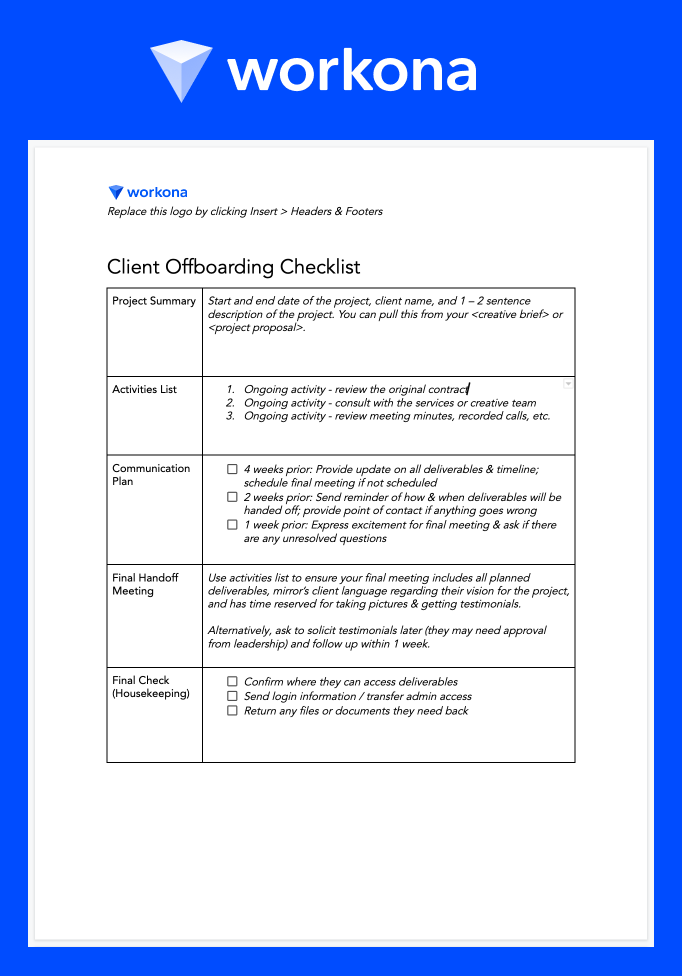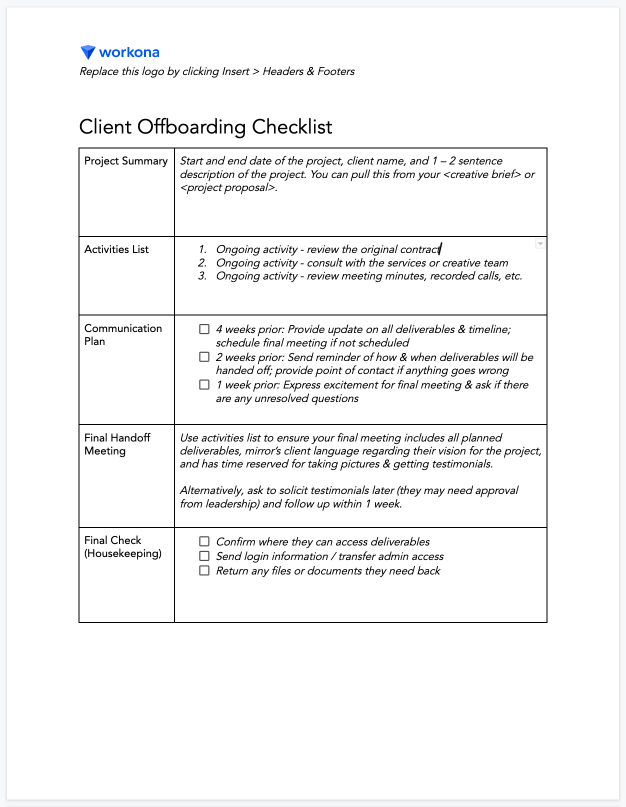
How To Build A Customer Offboarding Plan + Template
Saying goodbye to customers is one of the biggest challenges faced by freelancers, agencies, or any services team. Not only do you have to provide excellent service throughout, but the customer should leave the engagement on a high note — all because of the Peak-End Rule.
The Peak-End Rule states that people care most about two points in any experience: the peak stage (when the experience is most intense, when most work happens, etc.) and the final stage (how the experience is completed). The final impression sticks — a customer who walks away happy creates more word-of-mouth referrals, resulting in better branding for your services.
So how do you create a great final impression with a customer offboarding template? Check out our tips below & get your free Google Docs template here →

Jump to:
- What is customer offboarding?
- How to create a customer offboarding plan
- Grab your copy → Customer Offboarding Template | Google Docs
What is customer offboarding?
We're always excited to acquire new customers, so most customer success teams focus their energy on creating a world-class customer onboarding process. But what about the end of the relationship?
Successful agencies & freelancers understand that how you end the relationship is just as important as how it begins.
Customer offboarding is simply the process of saying goodbye to your customers. It can be summed up in two points:
- Make things easier on your customer, with the goal of building repeat business and gaining referrals based on their positive experience.
- Assure your team that the project was wrapped up completely.
Why do you need a customer offboarding plan?
It’s well understood that happy customers recommend brands, services, companies, and yes, freelancers with whom they have had a good experience. After all, 83% of satisfied customers recommend a brand to their friends or colleagues that they were satisfied with.
Meanwhile, there’s only a 15% chance that a customer will tell their colleagues about a company, service, or brand that disappointed them.
Besides referrals, another reason to make a formal customer offboarding plan is that you improve your chances of re-engaging the same customer in the future.
In short, a good send-off can increase your referral and retention rates. Win-win!
How to create a customer offboarding plan
Here are some tips to try when your next engagement ends:
1. Create a list of active tasks
First, make an exhaustive list of active tasks that you’re been working on for your customer. You can come up with this list in a few ways:
- Review the original contract, including goals and deliverables. Pay special attention to any aspirational language your customer used, so you can mirror it during the final hand-off meeting.
- Consulting with the services or creative team that has been fulfilling deliverables.
- Checking your meeting minutes, recorded video calls, and other documentation.
You won’t hand this list to your customer, but it will inform your final communications, helping your customer know exactly what’s going on as their project wraps up.
2. Follow your communication plan
As a customer project ends, it's easy to mentally move on to your other work. Be sure to stick to your existing communication plan so your customers feel confident that they'll get their final deliverables with no issues. As the project comes to a close, remind them in writing when and how they can expect to hear from you.
3. Plan a final hand-off meeting
You also need to plan a meeting to discuss and give your project's final deliverables to your customer. You’ll have the opportunity to give a summary of your activities with them and the strategic outcome of the projects.
This meeting is also a great time to get marketing materials from your happy customers, such as photos of the team & customer together that you can share on social media or your website.
4. Final check before ending the engagement
Next, make sure you share any file, material, and related documents to the customers that they need to access. Also, make sure you give them clear instructions or any notes about how to implement your deliverables, such as login information for a new website.
5. Ask for testimonials and feedback
At this point, both you and your customer should be feeling pleased. This is the right time to ask for feedback on how the project went, from their perspective. By asking for feedback on your work, you show a willingness to make your work better in the future.
It’s also a good time to ask them for testimonials about the process & quality of work. Remember, ask specific questions to get specific answers.
6. Send a thank-you card or gift
Last but not least, it’s a nice touch to send a thank-you card or gift card. What to say?
- Thank them for their engagement, responsiveness, or thoughtful feedback throughout the project
- Reiterate the scope of the project (as long as you feel this reflects well on your partnership!)
- Share something you personally enjoyed about working on the project
- Express your willingness to work together again in the future
Customer Offboarding Checklist - Google Doc Template
A great customer offboarding process will continue the momentum you built throughout the project. To get started, just follow our customer offboarding template in Google Docs.
How to use this customer offboarding template:
- Click this link
- Confirm that you want to make a copy
- Edit & rename the template as needed

If your customer work is scattered across lots of cloud apps, Workona can help. In Workona, workspaces unify scattered customer work, bringing together all the apps & resources your team needs to run your entire customer process. Learn how your success team can eliminate tedious tasks — hunting down links, creating docs & folders, organizing it all manually — with Workona.
About the author:
Adela Belin is a content marketer and blogger at Writers Per Hour. She is passionate about sharing stories with the hope to make a difference in people's lives and contribute to their personal and professional growth. Find her on Twitter and LinkedIn.